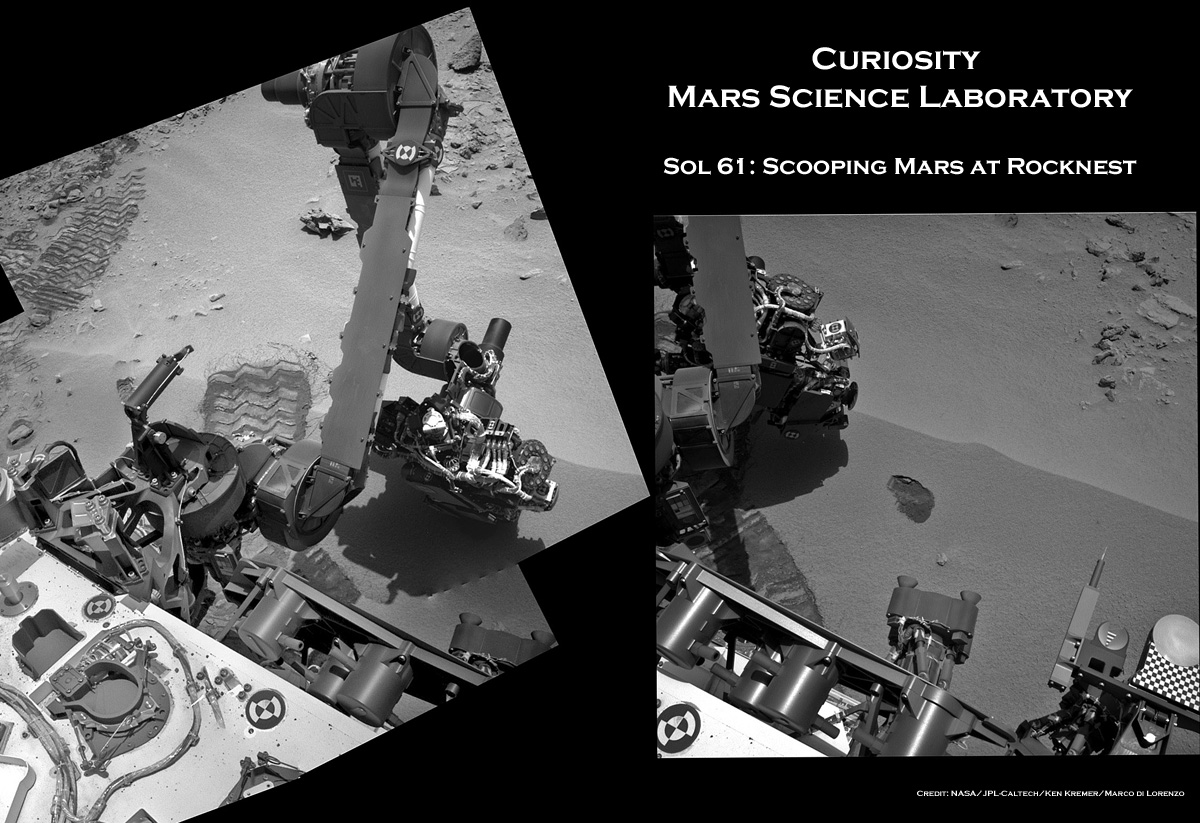Image Caption: Scooping Mars at ‘Rocknest’ mosaic shows a before and after view of the spot where Curiosity dug up her 1st Martian soil sample on Sol 61 (Oct 7. 2012). Navcam camera mosaic at left shows the arm at work during scooping operations. Image at right shows the tiny scooped trench measuring about 1.8 inches (4.5 centimeters) wide. See NASA JPL scooped sample vibration video below. Credit: NASA/JPL-Caltech/Ken Kremer/Marco Di Lorenzo
“Here’s the scoop: I like my regolith shaken!” tweeted NASA’s Curiosity Mars rover a short while ago in a nod to the 50th anniversary of the premiere of the 1st James Bond action flick.
And the “proof” is in the video as they say. See below a short NASA video clip showing the 1st Martian material collected using the small table spoon sized scoop on Curiosity’s robotic arm and subsequently being vibrated inside the scoop after it was lifted from the ground of Gale Crater this past weekend on Sol 61, Oct. 7, 2012.
Scooping Mars at ‘Rocknest’ mosaic above shows a before and after view of the spot where Curiosity was working at on Sol 61.
“So excited to dig in! One scoop of regolith ripple, coming right up!” she tweeted in the midst of the action.
Video Caption: This 256 frame video clip of Mastcam images shows the 1st sample of Martian material being vibrated inside Curiosity’s table spoon sized scoop on Oct. 7, 2012. Credit: NASA/JPL-Caltech/MSSS
Yeah baby ! Just as the rover’s science and engineers announced last week, the 6 wheeled mega robot Curiosity scored a major success by scooping up her very first sample of windblown Martian sand from the ‘Rocknest’ ripple she arrived at just last week.
The plan ahead is to use the collected “Red Planet” material to cleanse the interior of the rover’s sample-handling system of a residual layer of oily contamination of “Home Planet” material that could interfere with unambiguously interpreting the results.
For sure the science team doesn’t want any false positives with respect to any potential detection of the long sought organic compounds that could shed light on whether a habitant supporting Martian microbes ever existed in the past or present.
The newly collected material will be vibrated at 8 G’s and then be fed into Curiosity’s Collection and Handling for In-Situ Martian Rock Analysis (CHIMRA) device on the robotic arm turret.
Curiosity’s motorized scoop measures 1.8 inches (4.5 centimeters) wide, 2.8 inches (7 centimeters) long. The images reveal the scoop left behind a small hole about 1.8 inches (4.5 centimeters) wide.
Image Caption: Sol 61 Navcam raw image shows the hole dug up by Curioisty’s scoop on Oct. 7, 2012 Credit: NASA/JPL-Caltech
Image Caption: Mastcam 100 telephoto close up image of Rocknest trench on Sol 61. Credit: NASA/JPL-Caltech/MSSS
At last week’s Oct. 4 media briefing, the rover team said they would make three deliveries of scooped soil to cleanse out the sample acquisition system over the next two week or so before pouring sieved Mars material into the SAM and Chemin analytical chemistry labs on the rover’s deck for detailed evaluation of the elemental and mineralogical composition.


![NLA_402906079EDR_F0050104NCAM00326M_[1]](https://www.universetoday.com/wp-content/uploads/2012/10/NLA_402906079EDR_F0050104NCAM00326M_1-580x580.jpg)
![0061MR0319001000E1_DXXX[1]](https://www.universetoday.com/wp-content/uploads/2012/10/0061MR0319001000E1_DXXX11-580x435.jpg)
I think I can detect as many as 6 layers of soil in the trench either by colorations or shading differences. Are these real or caused by the process of digging the trench? If real can some sort of determination be made as the the length of time required to make these layers?